Historical changes in surgical strategy and complication management for hepatic cystic echinococcosis
Ji-De A, Jin-Ping Chai, Sheng-Long Jia, Xiang-Ren A
Abstract Echinococcosis is a zoonotic parasitic disease caused by Escherichia larvae. It frequently involves the liver (70%-75%), followed by the lungs (15%-20%), and occasionally the brain, heart, spleen, bone, and other organs. The main pathogenic forms of human echinococcosis currently include cystic echinococcosis (CE) and alveolar echinococcosis (AE). CE is globally distributed, while the distribution of AE is generally restricted to the northern hemisphere. In China, CE accounts for 75% of all echinococcosis cases. With rapid advances in surgical techniques in recent decades, the surgical strategy for CE has changed, especially with the continuous improvement of surgical methods and the expansion of surgical contraindications. To further understand the changes in surgical treatment strategies for hepatic CE, we interpreted and analyzed the existing literature addressing the surgical treatment of hepatic CE both domestically and abroad and briefly summarized them in chronological order. This review aims to provide a deeper understanding of the progress in the surgical treatment of hepatic CE to provide clearer avenues for its clinical diagnosis and treatment.
Key Words: Echinococcosis; Hepatic cystic; Internal capsule; External capsule;Complication; Surgical excision
INTRODUCTION
Echinococcosis, also known as hydatid disease, is a parasitic disease caused by the echinococcosis tapeworm larvae. The liver is the primary organ involved in echinococcosis, with the brain and other organs occasionally involved[1,2]. To date,at least five species of larvae have been reported to cause echinococcosis, includingEchinococcosis granulosus,Echinococcosis multilocularis,Echinococcosis oligarthrus,Echinococcosis vogeli, andEchinococcosis shiquicus. However, two main pathogens cause echinococcosis in humans:Echinococcosis granulosusandEchinococcosis multilocularis[3-5]. Cystic echinococcosis (CE), caused byEchinococcosis granulosus,is globally distributed, while alveolar echinococcosis (AE), caused byEchinococcosis multilocularis, is restricted to the northern hemisphere[6]. The distributions of CE and AE in China are slightly different from the global distribution of echinococcosis, where CE accounts for approximately 75% of all echinococcosis cases[7]. With the rapid advances in surgical techniques in recent decades, the surgical treatment strategy for CE has changed, especially with the continuous improvement of surgical methods and the expansion of surgical contraindications[8]. Original internal capsule excision is a widely used classical procedure because of its safety, practicality, and simplicity. However, owing to the high incidence of postoperative complications, especially residual cavity infection after long-term catheterization, which results in significant physical and psychological trauma, the procedure has been gradually abandoned[9]. Subsequently, various modified methods based on this procedure have evolved, such as internal capsule removal combined with omental tamponade and internal capsule removal combined with external capsule subtotal resection. Although these procedures have addressed many complications caused by partial residual cavity retention, they have not resolved persistent problems associated with internal capsule removal[10]. With the promotion of precision surgery, radical surgical procedures such as external capsule exfoliation and regular or irregular hepatectomy have gradually been accepted by most surgeons in the field[11]. These procedures significantly reduce the incidence of residual cavity complications associated with internal capsule exfoliation. However, radical surgery has stringent requirements for operators and surgical conditions; therefore, it is difficult to popularize this technique.Moreover, forced radical surgery can lead to fatal complications[12,13]. Specialists originally intended to design an individualized surgical plan from the perspective of patient and surgical safety. This article reviews surgical treatment strategies for hepatic CE and the historical evolution of postoperative complications (Table 1).
INITIAL SURGICAL TREATMENT FOR HEPATIC CE
Excision of the internal capsule
A case of successful internal capsule removal for liver CE was first described in 1871[14]. Excision of the internal capsule was the only surgery performed for CE during this period and is still used as a classical surgical approach (Figure 1).Subsequently, some investigators have proposed principles for CE surgery, specifically clearance of the internal capsule,prevention of the extravasation of cyst fluid, elimination of the residual cavity of the external capsule, and prevention of infection[15]. Excision of the internal capsule has the advantages of minimal surgical trauma, safety, and reliability and is a simple operation; however, each procedure has its own drawbacks. Indeed, many common complications can occur after internal capsule removal, such asin siturecurrence of the residual cavity, disseminated implantation, biliary fistula,residual cavity infection, and other refractory complications[16]. Some researchers have reported that the recurrence rates of liver CE after internal capsule exocytosis and biliary fistula are as high as 40% and 20%, respectively, and the incidence of residual cavity infection is as high as 65%[17-20]. The main reason for CE recurrence is rupture of the cyst during the operation or failure to completely eliminate the protoscolex when the inner CE cyst is removed, and the protoscolex left in the residual cavity continues to survive and ultimately develops into CE in the outer cavity[21]. The reason for intraperitoneal implantation is that the CE cyst fluid extravasates into the abdomen and pelvis during the operation,contaminating other abdominal organs, and a large number of larvae adhere to the peritoneal surface and survive. The main cause of postoperative biliary fistula is prolonged compression of the bile duct by a CE cyst, leading to intrahepatic bile duct distortion, atrophy, and even distal ischemic necrosis. In addition, owing to the corrosive effect of bile and the dramatic increase in luminal pressure, the external capsule and biliary tract are prone to form internal fistulas. The premise of a postoperative residual cavity infection is the existence of a residual cavity. Some patients experiencepreoperative cystic cavity infection, or the cyst wall is thick and calcified, and the residual cavity does not heal for a prolonged period. Another major cause of residual cavity infection is the presence of an internal biliary fistula on the cyst wall. When the pressure in the cyst sharply decreases, bile enters the residual cavity from the fistula and causes infection.
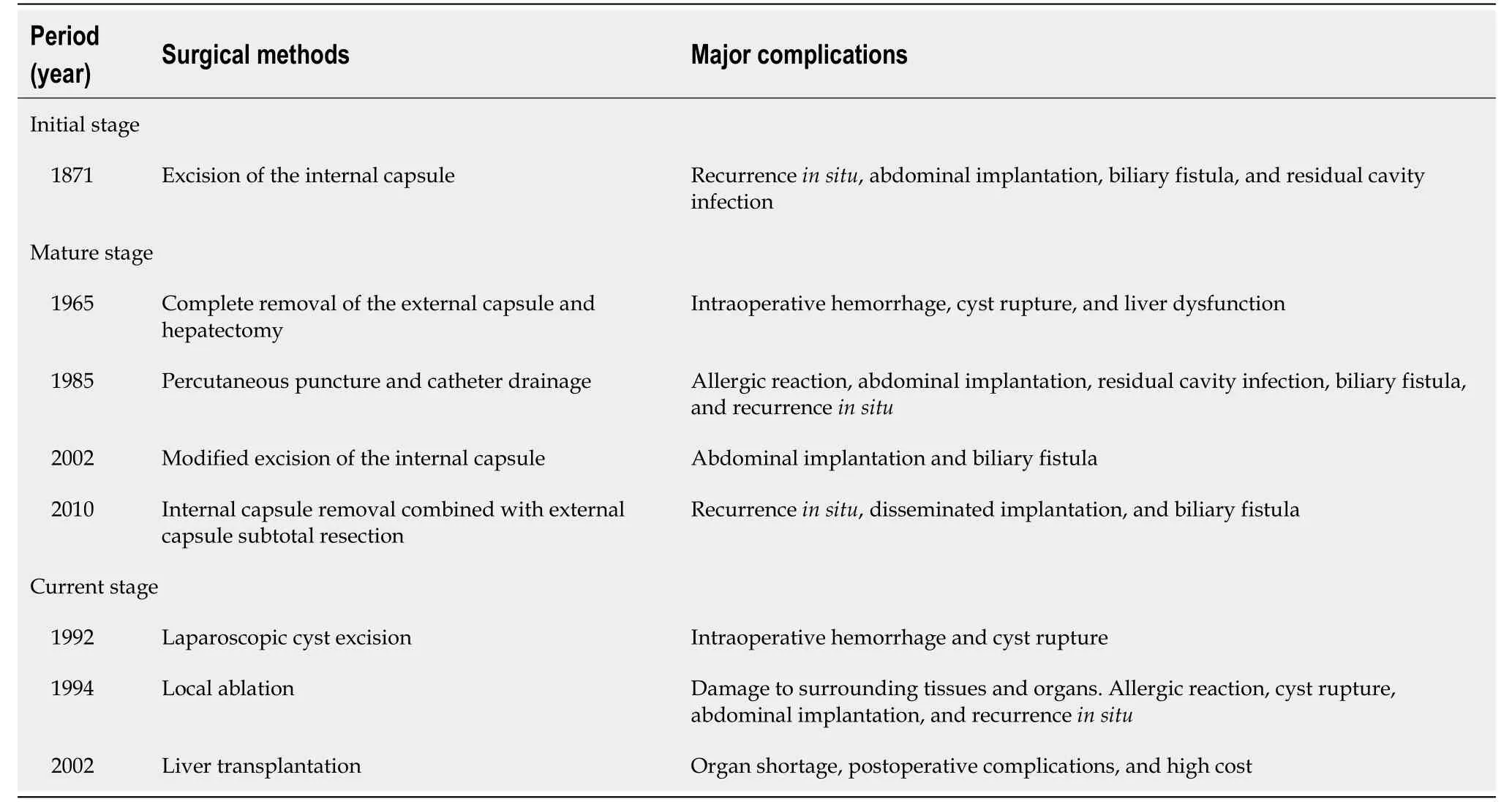
Table 1 Main surgical methods for hepatic cystic echinococcosis and their complications in different periods
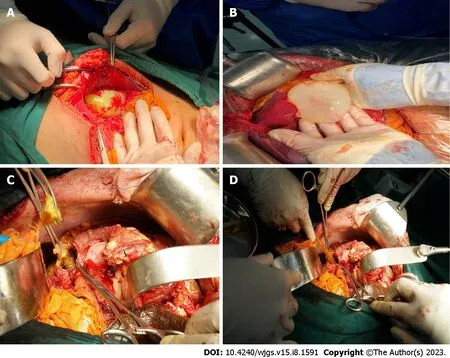
Figure 1 Excision of the internal capsule. A: After the incision of the peritoneum, the outer capsule of cystic echinococcosis (CE) was ruptured, and the inner capsule was intact; B: The gauze soaked with iodophor was used to isolate the surrounding organs and the intact ascus was removed carefully; C: The CE cyst was large in size and dense in adhesion with the diaphragm. Therefore, we chose to perform the internal capsule enucleation and found an internal fistula in the bile duct of the hydatid cyst, and the contents of the cyst were stained with bile; D: The aspirator aspirated the contents of the capsule, the capsule was repeatedly rinsed with iodophor and wiped with gauze, and a rubber drainage tube was placed.
MATURE STAGE OF SURGICAL TREATMENT FOR HEPATIC CE
Percutaneous puncture and catheter drainage of CE cysts
Advances and developments in modern medical science have led to a more comprehensive and in-depth understanding of CE, especially when a breakthrough was achieved in the puncture treatment of CE, in which the puncture diagnosis and treatment were no longer considered a “taboo”. In 1985, Livraghiet al[22] performed an ultrasound-guided diagnostic puncture for hepatic CE. In the same year, Mueller first reported the success of fine-needle puncture in the treatment of human hepatic CE[23]. In 1990, researchers reported ultrasound-guided puncture sclerotherapy for hepatic CE cysts in a large number of patients. This procedure is mainly aimed at patients with simple cyst-type CE who cannot tolerate surgery or for whom the effect of albendazole is not ideal. It has the advantages of less trauma, safety, effectiveness, low cost, and a short hospital stay[24]. Investigators domestically and abroad have reported that percutaneous tube puncture under ultrasound guidance combined with albendazole for the treatment of CE achieved curative effects similar to those of surgery[25]. Ultrasound-guided percutaneous puncture combined with drug therapy for CE is mainly used for cases of liver and abdominal wall adhesions caused by multiple operations and is a simple and less invasive method. Thousands of cases have been reported, both domestically and internationally. The rate of anaphylaxis and shock of puncture and extravasation of cyst fluid leading to CE implantation and dissemination is not higher than that of traditional surgical methods; as such, it is included in the World Health Organization (WHO) guidelines for the diagnosis and treatment of CE. However, some studies have reported that puncture treatment for CE is also associated with problems, including allergic reactions and cholangiosclerosis caused by head-extinguishing agents such as ethanol and formalin, residual cavity infection, biliary fistula, and recurrencein situ[26]. Some investigators have reported a complication rate of approximately 17%, a CE cyst infection rate of 2.6%, and anin siturecurrence rate as high as 40%[27-29]. To address this problem, researchers designed a special puncture instrument. Puncture and aspiration of the sac contents have been reported to have positive effects. However, the complication rate remained high after follow-up;therefore, this procedure was abandoned in China[30].
Modified excision of the internal capsule
At the beginning of the 20thcentury, Wen Hao first proposed modified enucleation of the internal capsule for the treatment of hepatic CE. The goal of this operation is to further reduce the incidence of high residual cavity complications after traditional internal capsule removal. A further improved surgical method is performed based on traditional internal capsule removal[31] to completely remove the internal capsule, remove the external capsule as far as possible, convert the large residual cavity into a small residual cavity, suture and repair the biliary fistula, manage the residual cavity with omental tamponade, which can reduce CE recurrence, abdominal spread, and the occurrence of refractory biliary fistula and residual cavity fluid infection. This surgery is suitable for patients with multiple cysts in whom the external capsule cannot be completely removed. Studies have reported that the incidence rates of biliary fistula and residual cavity infections were 17.56% and 2.70%, respectively. There were no recurrences or deaths, and the cure rate was reported to be 100%[10].
Total cystectomy
In 1965, French researchers proposed the concept of radical surgery for the complete removal of the CE external capsule.Penget al[32,33] reported, for the first time in 1999, the complete excision of a hepatic CE cyst inside the outer membrane,which was based on the liver resection technique, combined with experience in the surgical treatment of hepatic CE. The main technical point and radical purpose of this procedure are to completely remove the CE cyst along the potential gap between the external capsule of the CE and the normal liver tissue (Figure 2). Compared with traditional internal capsule extraction, this operation significantly reduces postoperative bile leakage, residual cavity infection, and recurrence. It is an ideal new surgical method for radical treatment, which has been recognized by the WHO and gradually popularized[34,35]. This procedure is suitable for patients with single or external cysts that can be completely resected. Complete excision of the external capsule can completely remove the lesion; however, this operation requires a high degree of knowledge and proficient surgical skills of the surgeon. Otherwise, the cyst could easily rupture during surgery, resulting in serious intraoperative complications. Some studies have reported that the incidence of biliary fistula complications after complete exfoliation of the external capsule is 2.34%, and the incidence of postoperative liver dysfunction is 3.03%.No cases of postoperative recurrence, residual cavity infection, implantation spread, or death occurred, and the cure rate was 100%[36]. However, owing to the expansive growth of CE cysts, some important vessels in the liver are compressed,deformed, and/or displaced, and an internal fistula may form. Although there is a potential gap between the external capsule and normal liver tissue, these vessels and bile ducts are likely to be destroyed during the removal of the external capsule. Furthermore, intraoperative hemorrhage is significantly increased compared with the removal of the internal capsule and subtotal removal of the external capsule[37,38].
Partial hepatectomy
In 2007, researchers reported that partial hepatectomy was used in France to treat hepatic CE as early as 1965[37]. With advances in liver surgery, hepatectomy has become one of the main radical treatments for hepatic CE[39]. Birnbaumet al[40] proposed that active hepatectomy has advantages over conservative internal capsule removal in the treatment of CE.However, not all CE cases should be treated by liver resection because regular liver resection removes part of the normal liver tissue at the same time as the resection of the lesion, especially when the residual liver volume is small; therefore,hepatectomy should be more conservative (Figure 3). This procedure is mainly suitable for patients with multiple and/or large lesions, thick and calcified CE cyst walls, or complications due to intracystic infection[32,41].
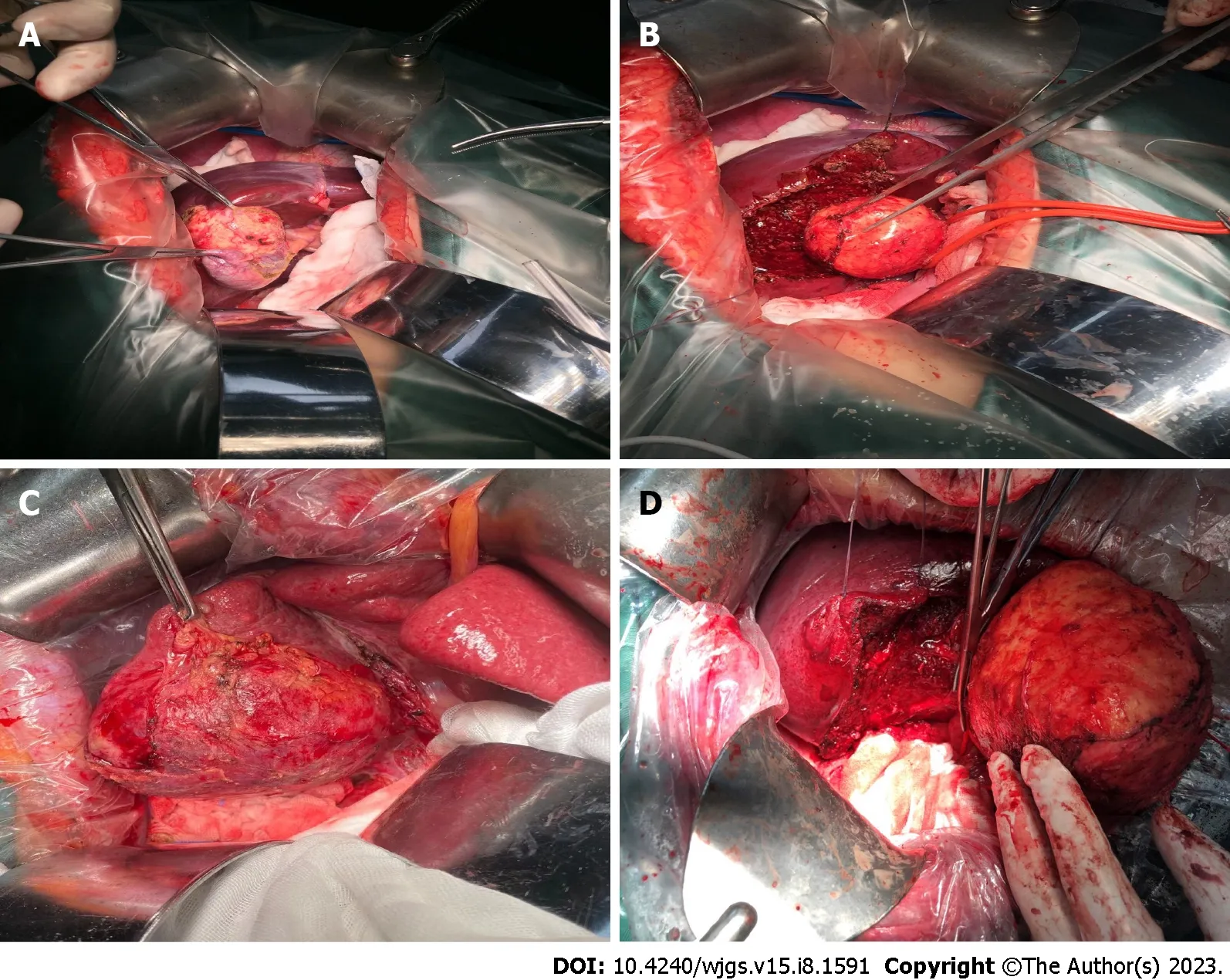
Figure 2 Total cystectomy. A: The cystic echinococcosis (CE) cyst was located behind the gallbladder, and the lesion size was small; B: The gallbladder and CE cyst were completely removed; C: CE cyst was located in the S5 and S6 segments of the liver, with a certain distance from the first and second hilum hepatitis; D:The CE cyst was completely removed along the edge of the external capsule, and the remaining liver section was definitely hemostatic.
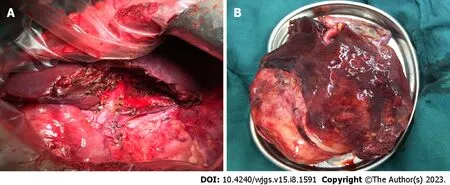
Figure 3 Partial hepatectomy. A: Cystic echinococcosis (CE) occupied the entire S3 segment of the liver, so segmentectomy was performed; B: Some liver tissue was observed on the surface of CE.
Internal capsule removal combined with external capsule subtotal resection
In 2010, researchers described the treatment of hepatic CE using internal capsule removal combined with subtotal resection[42]. This procedure combines the advantages of traditional endocystectomy and complete removal of the external capsule, particularly in patients with complex CE or in whom total cystectomy is difficult. Moreover, patients with CE cysts near the main hilar vessels and biliary tract achieved satisfactory results. The primary technical aspects include conventional internal capsule extraction followed by external capsule stripping along the potential gap of the CE external capsule, which maximally preserves the normal liver parenchyma and protects the surrounding hepatic duct system. Simultaneously, separation in this space also reduces bleeding without blocking blood flow into the liver, leaving a residue in the outer capsule wall near important blood vessels and the hilus. It aims to remove the outer capsule wall to the greatest extent possible, reduce the residual cavity volume, or eliminate the residual cavity, thereby significantly reducing postoperative residual cavity infections and biliary fistula complications. However, Zhanget al[43] found that,although subtotal external capsule resection removes part of the external capsule, it does not avoid the risk of a residual internal capsule. For example, during surgery, the internal capsule is routinely removed, and there is the possibility of dissemination and implantation of the cephalic segment during the removal of the internal capsule. In addition,compared with internal capsule resection, subtotal external capsule resection also requires the removal of part of the external capsule, which prolongs the operation and increases the surgical risk and incidence of postoperative complications.
CURRENT STATUS OF SURGICAL TREATMENT FOR HEPATIC CE
Laparoscopic CE cyst excision
With advances and developments in minimally invasive techniques, particularly laparoscopic surgery, to a higher level,the indications for surgery continue to expand and extend to the treatment of various diseases. The first case of laparoscopic liver CE internal capsule excision was reported[44]. In the ensuing ten years, several liver surgery centers in China have successively performed total laparoscopic complete cystectomies and laparoscopic hepatectomies to treat hepatic CE. Furthermore, laparoscopic hepatectomy is safe, reliable, minimally invasive, and has a rapid postoperative recovery[45,46]. However, the technical requirements for laparoscopic hepatectomy are high, the technological maturity curve is long, and cases must be carefully selected. The procedure needs to be performed in experienced endoscopic centers;therefore, it is difficult to promote wide-range adoption and a low recurrence rate in the short term. Moreover, surgical indications should be strictly controlled, such as those without a history of abdominal surgery, and cases with CE cysts located in the superficial part of the liver, and clear exposure of the surgical field[47]. Additionally, the three principles of CE surgery should be strictly observed during the procedure: No cystic fluid overflow, a fully inactivated original segment, and field isolation and protection. Attention should be paid to inactivating the extravasated cystic fluid to prevent infection and implant recurrence; therefore, the choice of indication must be emphasized.
Local ablation therapy for CE
With the popularization of minimally invasive concepts in recent years, local lesion ablation, a newly emerging minimally invasive technique, has been recognized by the medical community for the treatment of diseases, especially small lesions[48]. After more than 20 years of development, many domestic and foreign echinococcosis diagnosis and treatment centers have attempted to apply this technology to the treatment of CE or AE because of its simplicity, minimal trauma,low incidence of postoperative complications, and rapid recovery[49-52]. The echinococcosis diagnosis and treatment center of Qinghai Provincial People’s Hospital successfully performed radiofrequency ablation for liver CE disease in more than 40 cases. In addition, we found that patients with a smaller hepatic echinococcosis diameter had a shorter operative duration, less postoperative liver damage, and faster recovery of liver function. The operative duration for a single lesion is shorter than that for multiple lesions, the postoperative liver damage is less severe, and the short term clinical effect is good. Radiofrequency ablation has the advantages of being a simple operation that results in less trauma,rapid patient recovery, and fewer complications, and it can, to a certain extent, reduce the economic burden on patients.In addition, in patients with advanced age, poor pulmonary function, or cirrhosis who do not meet the indications for surgery or cannot undergo surgery, it can replace part of the traditional open surgery. However, there are also many uncertain factors in radiofrequency ablation, such as the severity of damage to the surrounding tissues and organs, which cannot be verified. Therefore, to reduce the damage to organs, tissues, and cells caused by radiofrequency ablation puncture, it is necessary to strictly observe operative specifications, accurate preoperative positioning, and careful intraoperative ultrasound guidance, and control the temperature and ablation time during radiofrequency ablation.Reducing the number of ablation attempts with a radiofrequency needle, repeated irregular insertion of the radiofrequency needle, and avoiding careless operations can effectively reduce damage to intrahepatic bile ducts, tissues, and cells.
Liver transplantation for hepatic CE
Hepatic CE lesions compress the second hilum, resulting in severe liver congestion. Traditional treatments cannot effectively improve liver function, hypersplenism, and portal hypertension or relieve abdominal fluid[9]. Allograft liver transplantation is performed when there is a risk of liver failure after autologous transplantation. However, liver transplantation has some shortcomings, such as organ shortage, postoperative complications, and high costs. Therefore,liver transplantation in patients with hepatic CE is rarely reported globally, and there are no records of liver and biliary disease treatment centers in the authors’ location.
Continuous improvements in interventional therapeutic technologies, such as laparoscopy, and their application in clinical practice have ushered in significant changes and breakthroughs in the diagnosis, treatment, and postoperative management of hepatic CE. The boundary between minimally invasive and traditional surgeries is constantly being broken, especially as laparoscopic surgery progresses to higher levels. The application of imaging techniques, such as computed tomography angiography, magnetic resonance cholangiopancreatography, and three-dimensional reconstruction, can reveal the relationship between CE lesions, liver vessels, and the biliary tract and provide detailed preoperative imaging for precision surgery for CE. Despite these remarkable achievements, problems persist in the diagnosis and treatment of hepatic CE. Accurate surgical prediction, postoperative evaluation, and the diagnosis and treatment of postoperative complications require further investigation.
MANAGEMENT OF COMPLICATIONS
Albendazole should be administered for a prolonged period after CE recurrence. Reoperation should be considered for patients with poor drug efficacy to prolong and improve their quality of life. Among patients who experience a postoperative biliary fistula, only unobstructed drainage is needed if the size of the biliary fistula is small. If stubborn biliary leakage occurs, which requires long-term catheterization or repeated debridement, and the liver is severely damaged, partial hepatectomy or reoperation can be performed. The leak is sutured, and biliary duct decompression or endoscopic duodenal papillary incision is made for biliary duct decompression, and the biliary leak can be closed by itself[21]. For patients with postoperative residual cavity infection, the first step is smooth drainage, followed by reasonable use of antibiotics to control the infection. If the infection persists, repeat surgical debridement or resection of the part of the liver with bile leakage should be considered to achieve recovery. To prevent recurrencein situor peritoneal implantation, intraoperative protection and isolation measures should be taken, such as using hypertonic saline or iodophor gauze to isolate the tissues and organs around the lesion during the operation, regularly taking albendazole after the operation, and follow-up work to achieve early detection and treatment as far as possible.
CONCLUSION
Compared with 200 years ago, there is a deeper understanding of the pathogenesis of CE, and medical diagnosis and treatment technologies have improved dramatically. However, key treatment principles for hepatic CE remain unchanged. Complete resection of the lesion and prevention of CE recurrence and implantation are lifelong pursuits of CE specialists. However, our team believes that because we cannot guarantee the integrity of the cyst, we should shift the focus of treatment to prevent the inactivation of the head segment, such as pre-inactivation of the head segment and solidification of the cyst fluid, which can not only reduce the implantation and recurrence rates of CE but also improve the safety of surgery. We hope that there will be qualitative breakthroughs in the surgical treatment of hepatic CE.
ACKNOWLEDGEMENTS
The authors gratefully acknowledge the helpful suggestions of the reviewers, who have improved the manuscript.
FOOTNOTES
Author contributions:A JD and Chai JP conceptualized the study, collected the data, designed the review, and drafted the original manuscript; Jia SL was responsible for the investigation and supervision; and A XR supervised and reviewed the final manuscript submitted for publication.
Supported bythe Qinghai Province Talent Action Plan of Kunlun; National Natural Science Foundation of China, No. 82260412; Basic Research Project of Qinghai Province, No. 2020-wjzdx-27; Qinghai Province 2022 Innovation Platform Construction Special Project, No.2022-ZJ-T01; and High-end Innovative Talent Project of Kunlun Talents of Qinghai Province in 2021.
Conflict-of-interest statement:The authors declare that they have no conflict of interest to disclose.
Open-Access:This article is an open-access article that was selected by an in-house editor and fully peer-reviewed by external reviewers.It is distributed in accordance with the Creative Commons Attribution NonCommercial (CC BY-NC 4.0) license, which permits others to distribute, remix, adapt, build upon this work non-commercially, and license their derivative works on different terms, provided the original work is properly cited and the use is non-commercial. See: https://creativecommons.org/Licenses/by-nc/4.0/
Country/Territory of origin:China
ORCID number:Ji-De A 0000-0003-4478-1972; Jin-Ping Chai 0000-0001-8873-1323; Xiang-Ren A 0000-0002-0305-996X.
S-Editor:Yan JP
L-Editor:Wang TQ
P-Editor:Yan JP
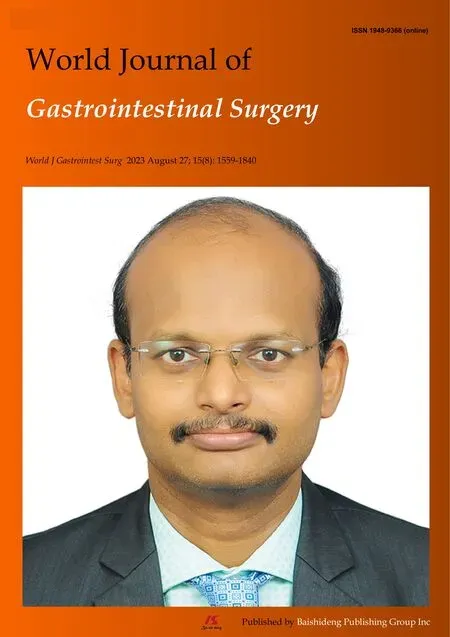 World Journal of Gastrointestinal Surgery2023年8期
World Journal of Gastrointestinal Surgery2023年8期
- World Journal of Gastrointestinal Surgery的其它文章
- Initial suction drainage decreases severe postoperative complications after pancreatic trauma: A cohort study
- Vascular complications of chronic pancreatitis and its management
- Post-transplant biliary complications using liver grafts from deceased donors older than 70 years:Retrospective case-control study
- Goldilocks principle of minimally invasive surgery for gastric subepithelial tumors
- Prognosis after splenectomy plus pericardial devascularization vs transjugular intrahepatic portosystemic shunt for esophagogastric variceal bleeding
- Prognostic scores in primary biliary cholangitis patients with advanced disease
